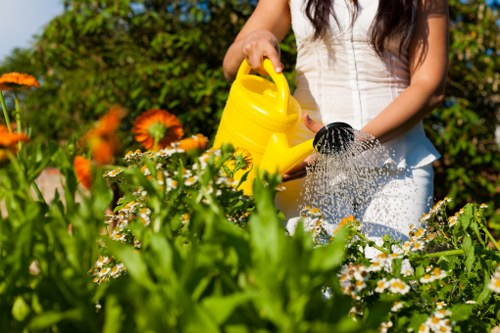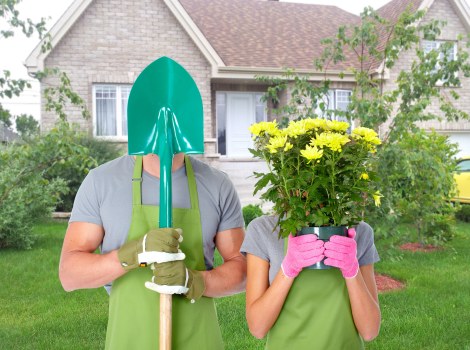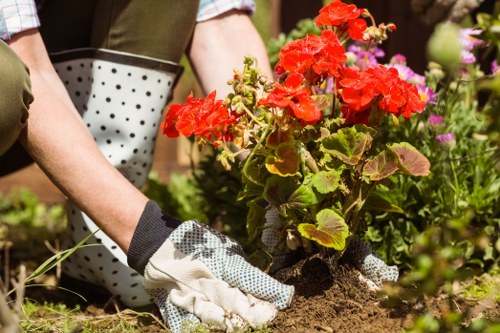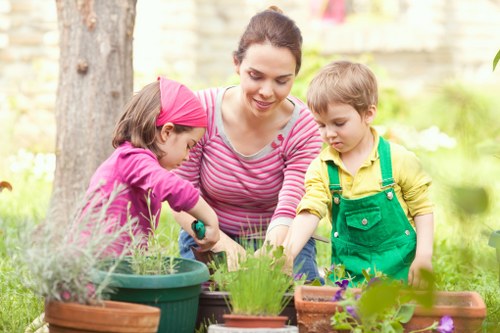Transform Your Home with Expert Landscape Gardening in Stratford

Introduction to Landscape Gardening in Stratford
Landscape gardening in Stratford is more than just planting flowers and trimming hedges; it's about creating a harmonious outdoor space that reflects your personal style and enhances the beauty of your property. Whether you're looking to redesign your garden, create a sustainable environment, or simply add some aesthetic appeal, professional landscape gardening services can help you achieve your vision.
Stratford offers a unique climate and soil conditions that influence the types of plants and gardening techniques best suited for the area. Understanding these local factors is crucial for successful landscape gardening, ensuring that your garden thrives year-round.
Investing in landscape gardening can significantly increase your property's value, provide a tranquil retreat, and offer a space for outdoor activities. With the right design and maintenance, your garden can become a source of pride and relaxation.

Benefits of Professional Landscape Gardening
Hiring professional landscape gardeners in Stratford comes with numerous advantages:
- Expertise: Professionals have the knowledge and experience to design and implement effective gardening solutions.
- Time-Saving: Landscaping can be time-consuming; professionals handle all aspects, allowing you to enjoy your garden without the hassle.
- Increased Property Value: A well-designed garden enhances curb appeal and can boost your home's market value.
- Customized Designs: Professionals tailor their services to meet your specific needs and preferences.
These benefits ensure that your investment in landscape gardening yields long-term satisfaction and aesthetic appeal.

Designing Your Dream Garden
Creating a stunning garden in Stratford begins with a thoughtful design process. Here are key steps to consider:
- Assessment: Evaluate your current garden space, considering factors like sunlight, soil quality, and existing structures.
- Planning: Develop a layout that includes plant selection, pathways, water features, and seating areas.
- Choosing Plants: Select native and climate-appropriate plants to ensure sustainability and ease of maintenance.
- Implementing Features: Incorporate elements like pergolas, garden beds, and decorative accessories.
- Maintenance Strategy: Establish a plan for regular upkeep to keep your garden thriving.
By following these steps, you can create a garden that not only looks beautiful but also functions seamlessly within your outdoor space.

Popular Plants for Stratford Gardens
Selecting the right plants is essential for a successful landscape garden in Stratford. Here are some popular choices:
- Rhododendrons: These vibrant flowers add color and thrive in Stratford's climate.
- Hostas: Ideal for shaded areas, hostas offer lush greenery and delicate flowers.
- Lavender: Known for its fragrance, lavender is perfect for sensory gardens.
- Japanese Maple: Provides stunning foliage and architectural interest.
- Hydrangeas: These versatile plants offer beautiful blooms throughout the seasons.
Choosing a mix of these plants can create a diverse and resilient garden that appeals to both the eye and the senses.

Sustainable Gardening Practices
Embracing sustainable practices in landscape gardening not only benefits the environment but also ensures the longevity of your garden. Here are some strategies:
- Water Conservation: Implementing drip irrigation systems and using mulch can reduce water usage.
- Native Plants: Utilizing native species supports local ecosystems and requires less maintenance.
- Composting: Recycling garden waste into compost enhances soil fertility and structure.
- Organic Fertilizers: Avoiding chemical fertilizers promotes healthy plant growth and soil biodiversity.
- Energy Efficiency: Incorporating solar lighting can reduce energy consumption.
By adopting these sustainable practices, your garden becomes a model of environmental stewardship and beauty.
Seasonal Maintenance Tips
Proper maintenance is key to keeping your Stratford garden in pristine condition throughout the year. Here are some seasonal tips:
- Spring: Prepare soil, plant new vegetation, and prune overgrown plants.
- Summer: Regular watering, weeding, and monitoring for pests.
- Autumn: Clear fallen leaves, plant bulbs for spring, and prepare for colder weather.
- Winter: Protect plants from frost, prune dormant trees, and plan for the next gardening season.
Following these tips ensures that your garden remains healthy and vibrant all year round.
Incorporating Hardscaping Elements
Hardscaping plays a crucial role in landscape gardening by adding structure and functionality. Popular hardscaping elements include:
- Patios: Create outdoor living spaces for relaxation and entertainment.
- Paths and Walkways: Guide visitors through your garden while preventing soil erosion.
- Water Features: Add tranquility with ponds, fountains, or waterfalls.
- Retaining Walls: Manage slopes and enhance the visual appeal of your garden.
- Decks: Provide elevated platforms for additional space.
Integrating these elements can transform your garden into a cohesive and inviting environment.
Choosing the Right Landscape Gardener
Selecting a skilled landscape gardener in Stratford is essential for achieving your desired results. Consider the following when making your choice:
- Experience: Look for professionals with a proven track record in landscape gardening.
- Portfolio: Review their previous projects to gauge their style and expertise.
- References: Seek testimonials from past clients to assess their reliability and quality of work.
- Licensing and Insurance: Ensure they are properly licensed and insured to protect your property.
- Communication: Choose a gardener who listens to your needs and communicates effectively.
By thoroughly evaluating potential gardeners, you can partner with a professional who aligns with your vision and standards.
Cost Considerations
The cost of landscape gardening in Stratford can vary based on several factors:
- Project Scope: Larger projects with more features will naturally cost more.
- Material Selection: The choice of plants, stones, and other materials affects the overall budget.
- Labor: Skilled labor comes at a premium, but ensures quality results.
- Maintenance: Ongoing maintenance costs should be factored into your budget.
- Customization: Customized designs tailored to your specific needs may require additional investment.
It's important to establish a clear budget and discuss costs upfront with your landscape gardener to avoid surprises and ensure that your project stays on track financially.
Enhancing Outdoor Living Spaces
Landscape gardening in Stratford isn't just about plants; it's also about creating outdoor living spaces that extend your home's functionality. Here are some ideas:
- Outdoor Kitchens: Perfect for entertaining guests and enjoying meals al fresco.
- Fire Pits: Provide warmth and a focal point for gatherings.
- Seating Areas: Comfortable benches or lounge chairs offer relaxation spots.
- Gazebos and Pergolas: Add shade and architectural interest to your garden.
- Lighting: Enhance safety and ambiance with strategically placed lighting fixtures.
Integrating these elements can turn your garden into a versatile and inviting space for various activities.
Seasonal Planting Strategies
Implementing seasonal planting strategies ensures a dynamic and colorful garden throughout the year:
- Spring Planting: Focus on bulbs, annuals, and early bloomers to kickstart your garden.
- Summer Planting: Incorporate heat-tolerant plants and use mulch to retain moisture.
- Autumn Planting: Plant perennials and shrubs that provide fall color and prepare for winter.
- Winter Planting: Select evergreen plants and add decorative elements to maintain visual interest.
By planning for each season, you can maintain a vibrant and appealing garden all year long.
Water Management in Gardens
Effective water management is crucial for a sustainable and healthy garden in Stratford:
- Irrigation Systems: Install automated systems for efficient watering.
- Rainwater Harvesting: Collect and reuse rainwater to reduce reliance on mains water.
- Drainage Solutions: Ensure proper drainage to prevent waterlogging and soil erosion.
- Pond Design: Incorporate water features that balance aesthetics with functionality.
- Drought-Resistant Plants: Choose plants that require minimal watering to conserve resources.
Implementing these strategies helps in maintaining a lush garden while being mindful of environmental conservation.
Creating a Wildlife-Friendly Garden
Attracting wildlife to your garden enhances its vibrancy and supports local ecosystems. Here's how:
- Native Plants: Provide habitat and food sources for local wildlife.
- Water Sources: Birds and other creatures are attracted to water features.
- Shelter: Incorporate bushes, trees, and other structures that offer protection.
- Avoid Pesticides: Use natural pest control methods to safeguard wildlife.
- Bird Feeders and Baths: Encourage birds to visit and thrive in your garden.
A wildlife-friendly garden not only supports biodiversity but also creates a lively and engaging outdoor environment.
Hardy and Perennial Plants
Choosing hardy and perennial plants ensures that your garden remains resilient and low-maintenance:
- Daylilies: Robust flowers that bloom throughout the summer.
- Hostas: Shade-tolerant plants with attractive foliage.
- Sedum: Drought-resistant succulents that add texture.
- Peonies: Long-lived perennials with beautiful blooms.
- Echinacea: Also known as coneflowers, they attract pollinators and are easy to grow.
Selecting these plants reduces the need for frequent replanting and ensures a consistent garden appearance.
Incorporating Edible Gardens
Integrating edible elements into your landscape garden adds functionality and sustainability. Consider the following:
- Herb Gardens: Grow herbs like basil, rosemary, and thyme for culinary use.
- Vegetable Patches: Cultivate vegetables such as tomatoes, peppers, and lettuce.
- Fruit Trees: Plant apple, pear, or citrus trees for fresh fruit.
- Berry Bushes: Add strawberries, raspberries, or blueberries for sweet treats.
- Raised Beds: Improve soil quality and drainage for optimal plant growth.
An edible garden not only provides fresh produce but also adds a unique and practical dimension to your landscape.
Lighting Your Garden
Proper lighting enhances the beauty and safety of your garden. Here are some tips:
- Path Lighting: Illuminate walkways to prevent accidents and guide visitors.
- Accent Lighting: Highlight key features like trees, sculptures, or water features.
- Ambient Lighting: Create a warm and inviting atmosphere for evening gatherings.
- Solar Lighting: Use energy-efficient solar lights to reduce electricity usage.
- String Lights: Add charm and flexibility with decorative string lighting.
Strategically placed lighting can transform your garden into a magical space after dark.
Maintaining Your Landscape Garden
Ongoing maintenance is essential for a thriving landscape garden in Stratford:
- Regular Watering: Ensure plants receive adequate moisture, especially during dry periods.
- Pruning and Trimming: Keep plants healthy and shapes defined.
- Weeding: Remove unwanted plants to prevent competition for resources.
- Fertilizing: Provide essential nutrients to support plant growth.
- Pest Control: Monitor and manage pests to protect your garden's integrity.
Consistent maintenance helps keep your garden vibrant and free from common issues.
Winterizing Your Garden
Preparing your garden for winter ensures its protection and readiness for the next season:
- Mulching: Add mulch to insulate plant roots and retain soil moisture.
- Protecting Plants: Use covers or burlap to shield delicate plants from frost.
- Clearing Debris: Remove fallen leaves and dead plants to prevent disease.
- Pruning: Trim back shrubs and trees to promote healthy growth in spring.
- Storage: Safely store garden tools and equipment to prevent damage.
Winterizing safeguards your garden's health and minimizes stress on plants during colder months.
Choosing Sustainable Materials
Incorporating sustainable materials into your landscape garden supports environmental responsibility and enhances aesthetic appeal:
- Recycled Stones: Use stones made from recycled materials for paths and borders.
- Sustainable Wood: Opt for responsibly sourced wood for structures like decks and pergolas.
- Eco-Friendly Pavers: Select permeable pavers that allow water infiltration.
- Bamboo Products: Incorporate bamboo for fences, decor, and other features.
- Organic Mulch: Choose natural mulches that enrich the soil without chemicals.
These materials contribute to a greener garden while providing durability and visual interest.
Garden Accessories and Decor
Adding accessories and decor elements personalizes your garden and enhances its charm:
- Garden Art: Sculptures, mosaics, and other art pieces add personality.
- Seating: Benches, swings, and chairs provide comfortable spots to enjoy your garden.
- Decorative Planters: Stylish containers can showcase plants in unique ways.
- Water Features: Incorporate fountains, ponds, or birdbaths for added beauty.
- Outdoor Rugs: Define areas and add color with weather-resistant rugs.
These touches make your garden not only beautiful but also uniquely yours.
Planning for Growth and Change
A successful landscape garden evolves over time. Consider the following when planning:
- Growth Patterns: Choose plants that complement each other's growth to prevent overcrowding.
- Future Additions: Design spaces where new plants or features can be added later.
- Adaptability: Ensure your garden can adapt to changing seasons and environmental conditions.
- Long-Term Maintenance: Plan for future maintenance needs as plants mature.
- Flexibility: Allow for adjustments in design to accommodate new ideas or preferences.
Planning for growth ensures your garden remains vibrant and functional as it matures.
Maximizing Small Garden Spaces
Even with limited space, you can create a beautiful and functional landscape garden in Stratford:
- Vertical Gardening: Use trellises and wall-mounted planters to maximize space.
- Compact Plant Varieties: Select dwarf or compact plant species to fit smaller areas.
- Multipurpose Furniture: Choose pieces that offer both seating and storage.
- Mirrors and Reflective Surfaces: Enhance the sense of space with reflective elements.
- Layered Planting: Create depth by layering plants of different heights.
These strategies help you make the most of small garden areas, creating a lush and inviting space.
Integrating Technology in Landscape Gardening
Modern technology can enhance the efficiency and aesthetic appeal of your landscape garden:
- Smart Irrigation Systems: Automate watering schedules based on weather conditions.
- Garden Monitoring Sensors: Track soil moisture, temperature, and other vital metrics.
- Outdoor Audio Systems: Add ambiance with integrated sound systems.
- Automated Lighting: Control garden lights remotely for convenience and security.
- Irrigation Controllers: Optimize water usage with programmable controllers.
Incorporating these technologies can make garden management easier and more effective.
Personalizing Your Garden Design
Your garden should reflect your personality and lifestyle. Here are some ideas for personalization:
- Themed Gardens: Create a specific theme like Japanese, Mediterranean, or cottage-style gardens.
- Color Schemes: Choose a color palette that resonates with you.
- Custom Structures: Add unique structures like custom pergolas or arbors.
- Artwork: Incorporate personal artwork or sculptures.
- Functional Zones: Designate areas for different activities like reading, gardening, or entertaining.
These elements make your garden a true extension of your home and personal taste.
Choosing the Right Soil
Soil quality is fundamental to a healthy landscape garden. Consider the following:
- Soil Testing: Conduct tests to determine pH levels and nutrient content.
- Soil Amendment: Add compost or other organic matter to improve soil structure and fertility.
- Drainage: Ensure proper drainage to prevent waterlogging and root rot.
- Aeration: Regularly aerate the soil to promote healthy root growth.
- Mulching: Apply mulch to conserve moisture and regulate soil temperature.
Proper soil management sets the foundation for a thriving garden.
Creating Privacy in Your Garden
Establishing privacy in your garden allows you to enjoy your outdoor space without disturbances:
- Hedges and Fences: Use dense hedges or tall fences to block views.
- Trellises with Climbing Plants: Grow plants like ivy or wisteria on trellises to create natural screens.
- Strategic Planting: Position plants in a way that shields certain areas of your garden.
- Pergolas and Gazebos: Install structures that provide both shade and privacy.
- Outdoor Curtains: Use weather-resistant curtains for flexible privacy solutions.
These techniques help create secluded areas for relaxation and personal enjoyment.
Choosing the Right Color Palette
The color palette in your garden influences its mood and aesthetic. Here are some tips:
- Complementary Colors: Use colors opposite each other on the color wheel for vibrant contrasts.
- Monochromatic Schemes: Incorporate various shades of a single color for a harmonious look.
- Analogous Colors: Use colors next to each other on the color wheel for a cohesive feel.
- Accent Colors: Add pops of bright colors to highlight specific areas or features.
- Neutral Colors: Use whites, grays, and browns to create a serene and balanced environment.
Carefully selecting your garden's color scheme can enhance its visual appeal and personal expression.
Incorporating Hardscape and Softscape
A balanced garden integrates both hardscape and softscape elements:
- Hardscape: Includes non-living elements like paths, patios, walls, and sculptures.
- Softscape: Comprises living elements such as plants, lawns, and flowers.
- Balance: Ensure a harmonious mix of hard and soft elements for aesthetic and functional balance.
- Texture and Contrast: Use different textures and materials to add depth and interest.
- Scale and Proportion: Match hardscape elements to the size of your garden for a cohesive look.
Integrating both types creates a dynamic and well-rounded garden space.
Garden Pathways and Layout
Pathways guide movement through your garden and enhance its structure:
- Material Selection: Choose from stone, gravel, wood, or pavers based on your garden's style.
- Design: Curved paths create a natural flow, while straight paths offer a formal look.
- Width: Ensure paths are wide enough for comfortable walking.
- Lighting: Illuminate paths for safety and ambiance.
- Borders: Add plant borders or edging to define pathways.
Well-designed pathways contribute to the garden's functionality and visual appeal.
Water Features and Their Benefits
Incorporating water features brings tranquility and life to your garden:
- Ponds: Support aquatic plants and wildlife, adding a natural element.
- Fountains: Provide the soothing sound of flowing water.
- Waterfalls: Create dynamic movement and visual interest.
- Streams: Integrate natural water flow into your garden layout.
- Birdbaths: Attract birds and add decorative charm.
Water features enhance the sensory experience of your garden, offering both aesthetic and ecological benefits.
Outdoor Lighting Solutions
Effective outdoor lighting can transform your garden by highlighting key features and ensuring safety:
- Solar Lights: Eco-friendly options that harness solar energy for illumination.
- LED Lighting: Energy-efficient and long-lasting, suitable for various garden applications.
- Spotlights: Highlight specific plants, trees, or architectural elements.
- String Lights: Add a festive and cozy atmosphere to seating areas or pathways.
- Motion Sensor Lights: Enhance security by activating when movement is detected.
Choosing the right lighting solutions can extend the usability of your garden into the evening hours while enhancing its beauty.
Creating Functional Garden Zones
Dividing your garden into distinct zones can improve its functionality and organization:
- Dining Area: A designated space for outdoor meals and gatherings.
- Relaxation Zone: Comfortable seating areas for unwinding and enjoying nature.
- Play Area: Safe spaces for children or pets to play.
- Garden Beds: Organized plantings for flowers, vegetables, or herbs.
- Storage: Areas for storing tools and garden equipment.
Functional zones enhance the versatility of your garden, making it a more enjoyable and practical space.
Incorporating Sustainable Energy Solutions
Integrating sustainable energy solutions can make your garden more eco-friendly:
- Solar Panels: Power garden lighting and water features with renewable energy.
- Wind Turbines: Harness wind energy for small-scale power needs.
- Rain Gardens: Manage stormwater runoff and reduce energy consumption.
- Composting Systems: Turn organic waste into nutrient-rich compost for your plants.
- Energy-Efficient Equipment: Use tools and machinery that consume less power.
These solutions reduce your garden's environmental impact and promote sustainability.
Garden Furniture and Accessories
Selecting the right furniture and accessories can enhance comfort and style:
- Weather-Resistant Furniture: Choose materials like teak, metal, or synthetic wicker that withstand outdoor conditions.
- Comfortable Seating: Invest in cushions and ergonomic designs for extended comfort.
- Decorative Pillows: Add color and texture to your seating arrangements.
- Umbrellas and Shade Structures: Provide protection from the sun and create comfortable outdoor spaces.
- Outdoor Rugs: Define spaces and add warmth and style to your garden areas.
Quality furniture and thoughtful accessories make your garden a more inviting and pleasant place to spend time.
Garden Maintenance Services in Stratford
Professional garden maintenance services ensure that your landscape remains beautiful and healthy throughout the year. These services typically include:
- Lawn Care: Mowing, fertilizing, and pest control to keep your lawn lush.
- Pruning and Trimming: Regularly shaping plants and trees for optimal growth.
- Planting Services: Adding new plants, flowers, and shrubs to enhance your garden.
- Weed Control: Removing unwanted vegetation to maintain garden aesthetics.
- Seasonal Cleanup: Preparing your garden for different seasons with appropriate tasks.
Hiring maintenance services allows you to enjoy a pristine garden without the constant effort of upkeep.
Using Mulch Effectively
Mulching offers multiple benefits for your garden, including moisture retention and weed suppression:
- Types of Mulch: Organic options like bark, compost, and straw; inorganic choices like gravel and rubber.
- Application: Spread mulch evenly around plants, maintaining a few inches from plant stems.
- Thickness: A layer of 2-3 inches is generally sufficient for most gardens.
- Maintenance: Replenish mulch as needed to maintain effectiveness.
- Benefits: Improves soil health, reduces watering needs, and enhances garden appearance.
Proper mulch application contributes to a healthier and more manageable garden environment.
Implementing Vertical Gardens
Vertical gardens are an excellent solution for maximizing space and adding greenery:
- Living Walls: Install panels or frames for growing a variety of plants vertically.
- Trellises and Arbors: Support climbing plants and create vertical interest.
- Hanging Planters: Utilize vertical space for herbs, flowers, or succulents.
- Container Gardens: Arrange containers on walls or structures for easy maintenance.
- Green Screens: Use plants to create privacy while adding a natural barrier.
Vertical gardens enhance the visual appeal and functionality of your outdoor space, especially in limited areas.
Choosing the Right Tools for Garden Care
Having the right tools is essential for effective garden maintenance. Consider these essentials:
- Hand Tools: Trowels, pruners, and gloves for detailed work.
- Lawn Equipment: Mowers, trimmers, and edgers for maintaining your lawn.
- Watering Tools: Hoses, sprinklers, and watering cans for efficient irrigation.
- Soil Tools: Shovels, rakes, and cultivators for soil preparation and planting.
- Garden Storage: Organize tools with sheds, racks, or toolboxes.
Investing in quality tools makes garden tasks easier and ensures better results.
Creating a Themed Garden
Themed gardens offer a cohesive and immersive experience. Popular themes include:
- Japanese Garden: Features like koi ponds, stone lanterns, and minimalist plantings.
- Mediterranean Garden: Incorporates drought-tolerant plants, terracotta pots, and vibrant colors.
- Cottage Garden: A mix of flowers, herbs, and casual plantings with a charming, informal style.
- Modern Garden: Clean lines, geometric shapes, and contemporary materials.
- Butterfly Garden: Plants that attract and support butterflies and other pollinators.
Choosing a theme helps guide your design choices and creates a unified look in your garden.
Edible Landscaping
Edible landscaping combines beauty with functionality by incorporating food-producing plants into your garden:
- Herb Borders: Plant herbs along pathways or garden edges for easy access.
- Fruit Trees: Integrate trees that provide shade and produce fruit.
- Vegetable Gardens: Designate specific areas for growing vegetables.
- Edible Flowers: Use flowers like nasturtiums and pansies that are both beautiful and edible.
- Container Gardening: Grow edible plants in pots and containers for flexibility.
Edible landscaping enhances your garden's productivity while maintaining its aesthetic appeal.
Incorporating Native Plants
Native plants are well-suited to the local climate and support local wildlife. Benefits include:
- Adaptability: Thrive in Stratford's specific climate and soil conditions.
- Low Maintenance: Require less water and care once established.
- Biodiversity: Support local insects, birds, and other wildlife.
- Environmental Benefits: Help prevent soil erosion and improve air quality.
- Cost-Effective: Often more affordable due to their hardiness.
Incorporating native plants leads to a sustainable and resilient garden ecosystem.
Creating Shade and Shelter
Shade and shelter elements make your garden more comfortable and versatile:
- Trees: Provide natural shade and cooling for your garden areas.
- Shade Sails: Modern and flexible solutions for covering larger spaces.
- Pergolas: Offer structured shade and can be adorned with climbing plants.
- Umbrellas: Portable and adjustable shading options.
- Natural Structures: Use plantings and landscaping features to create shaded areas.
These features enhance usability and comfort in your garden, making it enjoyable even during hot weather.
Integrating Art into Your Garden
Artistic elements add a unique and personal touch to your landscape garden:
- Sculptures: Introduce statement pieces that serve as focal points.
- Murals: Paint garden walls or structures for vibrant displays.
- Decorative Stones: Use patterned or colored stones for pathways and borders.
- Water Art: Incorporate artistic water features like artistic fountains.
- Functional Art: Choose aesthetically pleasing and functional items like artistic benches.
These artistic integrations elevate the visual appeal and personal significance of your garden.
Maximizing Garden Privacy
Ensuring privacy in your garden allows for a more intimate and secluded outdoor experience:
- Plant Barriers: Use tall plants or hedges to block views from neighbors.
- Fencing: Install durable and attractive fences for clear boundaries.
- Screening Structures: Incorporate pergolas or trellises with climbing plants for natural privacy screens.
- Strategic Layout: Position seating and activity areas away from public view.
- Privacy Screens: Use decorative screens or panels to obscure certain garden sections.
Implementing these strategies creates a serene and private sanctuary within your garden.
Enhancing Garden Paths
Garden paths guide movement and add structure to your landscape:
- Material Choices: Select materials that complement your garden's style, such as gravel, stone, or wood.
- Design Patterns: Incorporate curves, straight lines, or intricate patterns for visual interest.
- Lighting Integration: Illuminate paths for safety and nighttime beauty.
- Borders: Define paths with edging materials or plantings.
- Accessibility: Ensure paths are wide and even for easy traversal.
Well-designed paths enhance both functionality and aesthetics in your garden.
Garden Irrigation Systems
Efficient irrigation systems are vital for maintaining a healthy garden:
- Drip Irrigation: Delivers water directly to plant roots, reducing waste.
- Sprinkler Systems: Ideal for covering large lawn areas uniformly.
- Smart Controllers: Automate watering schedules based on weather and soil moisture.
- Rain Sensors: Prevent overwatering during rain, conserving water.
- Irrigation Zones: Customize watering for different garden areas based on plant needs.
Implementing an efficient irrigation system ensures optimal plant health while conserving water.
Personalizing Your Outdoor Space
Make your garden uniquely yours with personalized touches:
- Custom Signage: Add personalized signs or plaques to mark areas or display messages.
- Memory Stones: Incorporate stones engraved with meaningful dates or names.
- Personal Artifacts: Display items that hold sentimental value, like vintage tools or family heirlooms.
- Unique Planters: Use unconventional containers to showcase your favorite plants.
- Color Coordination: Align plant colors and decor to your favorite color schemes.
These personalized elements make your garden a true reflection of your personality and experiences.
Creating a Relaxing Atmosphere
A relaxing garden environment promotes mental well-being and tranquility:
- Seating Areas: Comfortable benches or hammocks provide places to unwind.
- Water Sounds: Include water features like fountains or streams for soothing sounds.
- Aromatherapy: Plant fragrant flowers and herbs to engage your senses.
- Soft Lighting: Use gentle lighting to create a calming ambiance in the evenings.
- Natural Elements: Incorporate natural materials like wood and stone for a harmonious feel.
By focusing on these elements, you can create a sanctuary that fosters relaxation and peace.
Garden Safety Tips
Ensuring safety in your garden is paramount for a worry-free outdoor experience:
- Non-Slip Surfaces: Use materials that prevent slipping, especially in wet areas.
- Proper Tool Storage: Keep tools stored securely to avoid accidents.
- Safe Lighting: Install electrical fixtures correctly to prevent hazards.
- Plant Selection: Choose non-toxic plants if you have pets or children.
- Clear Pathways: Ensure walkways are free from obstructions.
Adhering to these safety tips creates a secure and enjoyable garden environment.
Final Thoughts on Landscape Gardening in Stratford
Landscape gardening in Stratford offers endless possibilities to create a beautiful, functional, and sustainable outdoor space. By leveraging local expertise, choosing the right plants and materials, and implementing thoughtful design and maintenance strategies, you can transform your garden into a personal haven.
Whether you're embarking on a complete garden redesign or seeking to enhance specific areas, professional landscape gardening services can guide you every step of the way. Embrace the art and science of gardening to enjoy a thriving garden that brings joy and tranquility to your life.
Contact us today to start your landscape gardening journey in Stratford and turn your outdoor dreams into reality.